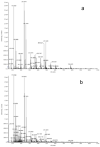Bronchoalveolar Lavage Fluid-Isolated Biomarkers for the Diagnostic and Prognostic Assessment of Lung Cancer
- PMID: 36552956
- PMCID: PMC9776496
- DOI: 10.3390/diagnostics12122949
Bronchoalveolar Lavage Fluid-Isolated Biomarkers for the Diagnostic and Prognostic Assessment of Lung Cancer
Abstract
Lung cancer is considered one of the most fatal malignant neoplasms because of its late detection. Detecting molecular markers in samples from routine bronchoscopy, including many liquid-based cytology procedures, such as bronchoalveolar lavage fluid (BALF), could serve as a favorable technique to enhance the efficiency of a lung cancer diagnosis. BALF analysis is a promising approach to evaluating the tumor progression microenvironment. BALF's cellular and non-cellular components dictate the inflammatory response in a cancer-proliferating microenvironment. Furthermore, it is an essential material for detecting clinically significant predictive and prognostic biomarkers that may aid in guiding treatment choices and evaluating therapy-induced toxicities in lung cancer. In the present article, we have reviewed recent literature about the utility of BALF analysis for detecting markers in different stages of tumor cell metabolism, employing either specific biomarker assays or broader omics approaches.
Keywords: biomarkers; bronchoalveolar lavage fluid; lung neoplasm; tumor microenvironment.
Conflict of interest statement
The authors declare no conflict of interest.
Figures



Similar articles
-
Discovery of potential protein biomarkers of lung adenocarcinoma in bronchoalveolar lavage fluid by SWATH MS data-independent acquisition and targeted data extraction.J Proteomics. 2016 Apr 14;138:106-14. doi: 10.1016/j.jprot.2016.02.010. Epub 2016 Feb 18. J Proteomics. 2016. PMID: 26917472 Clinical Trial.
-
Detection of K-ras oncogene mutations in bronchoalveolar lavage fluid for lung cancer diagnosis.J Natl Cancer Inst. 1995 Jul 19;87(14):1056-60. doi: 10.1093/jnci/87.14.1056. J Natl Cancer Inst. 1995. PMID: 7616596
-
Bronchoalveolar lavage fluid assessment facilitates precision medicine for lung cancer.Cancer Biol Med. 2023 Dec 29;21(3):230-51. doi: 10.20892/j.issn.2095-3941.2023.0381. Cancer Biol Med. 2023. PMID: 38164737 Free PMC article. Review.
-
Metabolic profiling of potential lung cancer biomarkers using bronchoalveolar lavage fluid and the integrated direct infusion/ gas chromatography mass spectrometry platform.J Proteomics. 2016 Aug 11;145:197-206. doi: 10.1016/j.jprot.2016.05.030. Epub 2016 May 30. J Proteomics. 2016. PMID: 27255828
-
EVs from BALF-Mediators of Inflammation and Potential Biomarkers in Lung Diseases.Int J Mol Sci. 2021 Apr 1;22(7):3651. doi: 10.3390/ijms22073651. Int J Mol Sci. 2021. PMID: 33915715 Free PMC article. Review.
Cited by
-
Myrtenol ameliorates inflammatory, oxidative, apoptotic, and hyperplasic effects of urethane-induced atypical adenomatous hyperplasia in the rat lung.Naunyn Schmiedebergs Arch Pharmacol. 2025 Feb;398(2):1785-1797. doi: 10.1007/s00210-024-03375-2. Epub 2024 Aug 23. Naunyn Schmiedebergs Arch Pharmacol. 2025. PMID: 39177787
-
Discrimination of Lung Cancer and Benign Lung Diseases Using BALF Exosome DNA Methylation Profile.Cancers (Basel). 2024 Aug 5;16(15):2765. doi: 10.3390/cancers16152765. Cancers (Basel). 2024. PMID: 39123492 Free PMC article.
-
Evaluating the comprehensive diagnosis efficiency of lung cancer, including measurement of SHOX2 and RASSF1A gene methylation.BMC Cancer. 2024 Mar 2;24(1):282. doi: 10.1186/s12885-024-12022-1. BMC Cancer. 2024. PMID: 38429660 Free PMC article.
-
Current Biomarkers in Non-Small Cell Lung Cancer-The Molecular Pathologist's Perspective.Diagnostics (Basel). 2025 Mar 5;15(5):631. doi: 10.3390/diagnostics15050631. Diagnostics (Basel). 2025. PMID: 40075878 Free PMC article. Review.
-
Metabolomics Analysis and Diagnosis of Lung Cancer: Insights from Diverse Sample Types.Int J Med Sci. 2024 Jan 1;21(2):234-252. doi: 10.7150/ijms.85704. eCollection 2024. Int J Med Sci. 2024. PMID: 38169594 Free PMC article. Review.
References
-
- Howlader N., Noone A., Krapcho M., Miller D., Brest A., Yu M., Ruhl J., Tatalovich Z., Mariotto A., Lewis D., et al. SEER Cancer Statistics Review, 1975–2018. National Cancer Institute; Bethesda, MD, USA: 2021.
-
- Wongsurakiat P., Wongbunnate S., Dejsomritrutai W., Charoenratanakul S., Tscheikuna J., Youngchaiyud P., Pushpakom R., Maranetra N., Nana A., Chierakul N., et al. Diagnostic value of bronchoalveolar lavage and postbronchoscopic sputum cytology in peripheral lung cancer. Respirology. 1998;3:131–137. doi: 10.1111/j.1440-1843.1998.tb00111.x. - DOI - PubMed
Publication types
LinkOut - more resources
Full Text Sources

